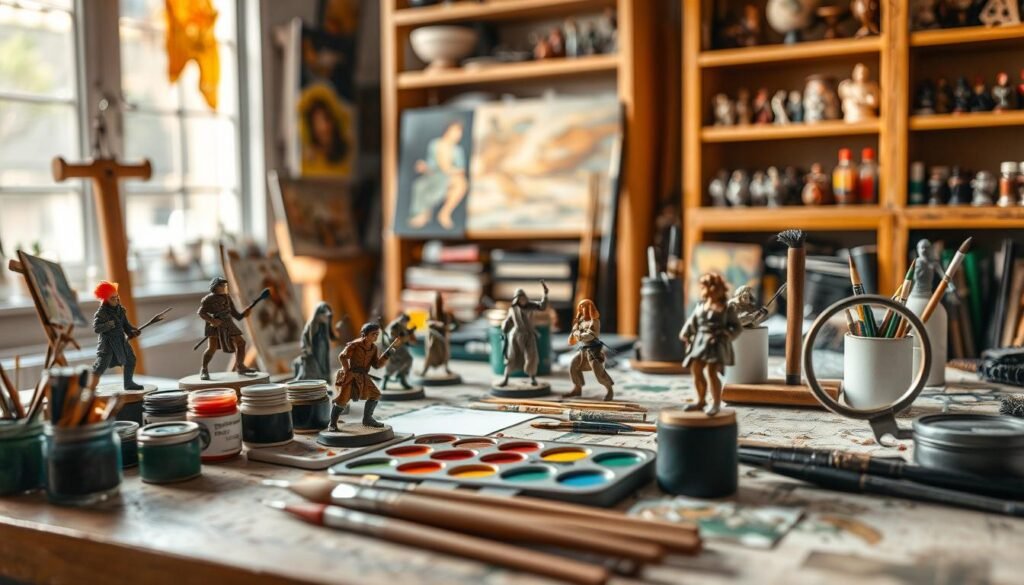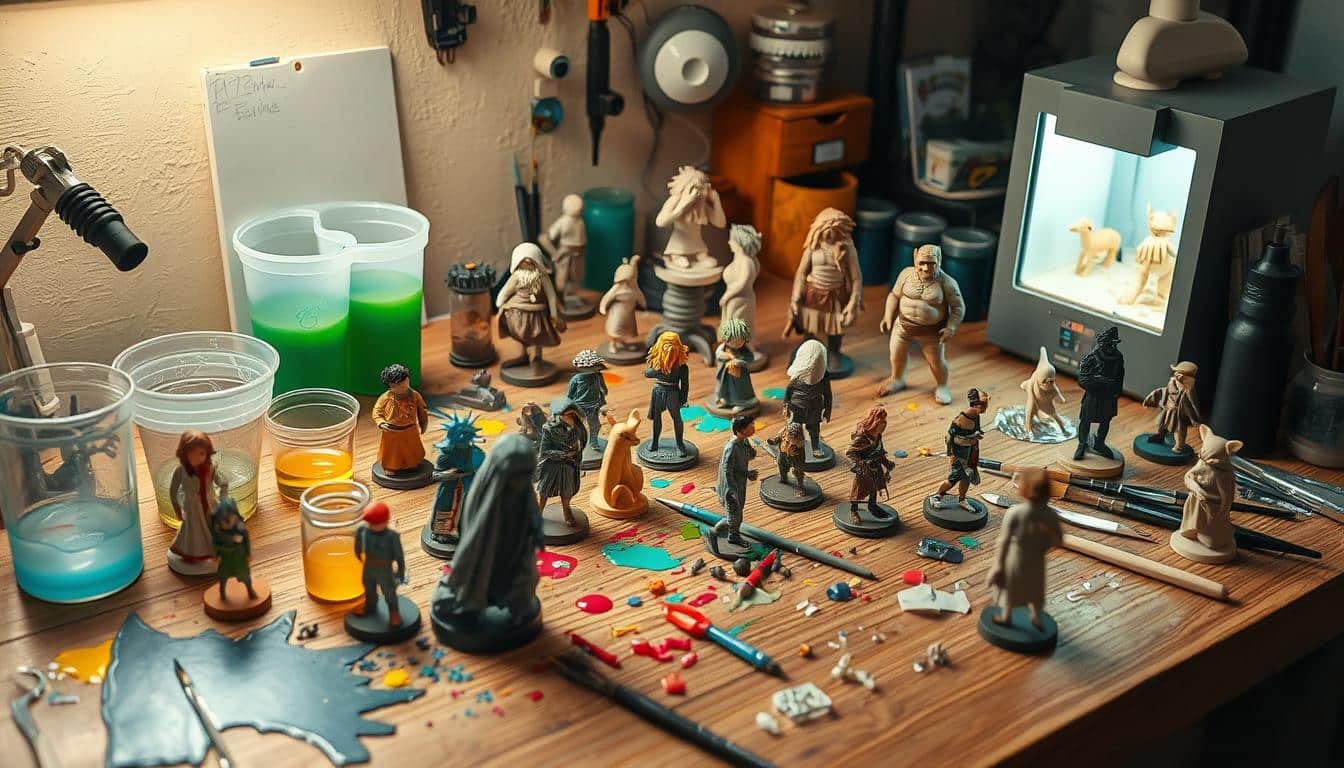3D printers for miniatures are now more affordable than ever. You can get a low-end hobbyist desktop model for under $5001. This has sparked a revolution in model making and hobby crafts.
Mastering resin casting for miniature figurines unlocks endless creative possibilities. You can bring intricate fantasy characters and detailed architectural models to life with stunning precision.
This guide covers essential resin casting steps. We’ll discuss workspace setup, mixing ratios, and curing times. You’ll learn to choose the right tools and materials for professional-quality results.
We’ll explore Stereolithography (SLA) and Selective Laser Sintering (SLS) technologies. These offer different levels of detail and complexity. SLA is often preferred for finely detailed miniatures.
SLA boasts top ratings in resolution and surface finish1. By the end, you’ll have the knowledge to create stunning, highly detailed miniatures.
Key Takeaways
- Affordable 3D printers have made resin casting more accessible to hobbyists
- Different technologies offer varying levels of detail and complexity
- SLA technology excels in creating highly detailed miniatures
- Proper workspace setup and safety precautions are crucial
- Mastering mixing ratios and curing times is key to successful resin casting
- Post-processing techniques can enhance the final quality of your miniatures
Essential Tools and Materials for Resin Casting
Resin casting is key for prop-makers and artisans. About 90% of daily items rely on casting for production2. To start, you’ll need the right tools and materials.
Required Basic Tools and Equipment
Your toolkit should include modeler’s files, emery boards, and wet-or-dry sandpaper. You’ll also need a modeling knife, tweezers, scissors, clothespegs, toothpicks, and paintbrushes.
For adhesives, keep alpha cyanacrylate (ACC) or epoxy handy. Clear water-based adhesive works well for small parts.
Types of Resin and Their Properties
Resin casting mixes two liquid parts. Polyurethane resin needs equal parts mixing. Polyester resin uses resin and a small amount of hardener2.
Resin typically sets within 30 minutes. It’s great for delicate, detailed forms2. Choose a 1-to-1 mixture type for easier handling3.
Safety Equipment and Workspace Setup
Safety is crucial in resin casting. Use gloves and goggles, and work in a well-ventilated space. A vacuum chamber helps remove air bubbles from silicone during pouring3.
Mold Making Materials and Supplies
Silicone rubber is the top choice for flexible mold making2. Oomoo 30 silicone is affordable and easy to mix. It uses a 1-to-1 mixing ratio3.
Most silicone materials need 24 hours to cure properly2. Plan your project timeline accordingly.
| Material | Mixing Ratio | Curing Time | Best For |
|---|---|---|---|
| Polyurethane Resin | 1:1 | 30 minutes | Detailed forms |
| Silicone (Oomoo 30) | 1:1 | 24 hours | Flexible molds |
| Plaster | Varies | 30 minutes – 24 hours | Bulky forms |
Success in resin casting often requires degassing the resin before pouring. Carefully manage air bubbles during the process3. With these tools, you’re set to explore resin casting for miniatures.
How to Diecast Resin for Miniatures
Resin casting is key for creating amazing miniatures. This guide covers workspace prep, mixing methods, bubble removal, and curing. You’ll learn the essentials for crafting stunning miniatures.
Preparing Your Workspace and Materials
Set up a clean, well-ventilated area for your project. Gather resin, molds, and safety gear. Resin models offer fine details that are hard to match.
They’re more delicate than diecast models4. Keep your workspace dust-free to avoid flaws in your final product.
Mixing and Pouring Techniques
Precise measuring and thorough mixing are vital for success. Use a digital scale for accurate ratios. Mix slowly to reduce air bubbles.
Pour the resin in a thin stream to limit trapped air. For intricate miniatures, use resin with a 35-micron pixel size or smaller5.
Preventing and Removing Air Bubbles
Air bubbles can spoil your miniature’s look. Here’s how to prevent them:
- Warm your resin before mixing to lower its viscosity
- Use a vacuum chamber to remove bubbles from the mixed resin
- Tap the mold gently after pouring to release trapped air
- Use a heat gun or torch to pop surface bubbles
Proper Curing Times and Conditions
Curing is crucial for a strong, durable miniature. Follow the maker’s instructions for curing times and conditions. Resin cures best in a warm, dry setting.
Some resins benefit from post-curing under UV light. This can add extra strength to your miniature.
| Resin Type | Cure Time | Ideal Temperature |
|---|---|---|
| Standard Epoxy | 24-48 hours | 70-80°F (21-27°C) |
| UV Resin | 1-2 minutes | Room temperature |
| Polyurethane | 4-8 hours | 75-85°F (24-29°C) |
For final touches, try cyanoacrylate (super glue) to assemble your resin miniatures. It’s fast-acting and works on most surfaces6.
These methods will help you create high-quality resin miniatures. With practice, you’ll master the art of resin casting.
Scale and Detailing Techniques for Perfect Results

Mastering scale and detailing is vital in painting miniatures and model making. Scales like 1:8 and 1:12 offer great chances for intricate work78. Your scale choice affects your approach to hobby crafts.
Acrylic polymers are perfect for painting miniatures. They create a clean surface for paint to stick9. Artist acrylics, house paints, and special model paints are popular choices9.
For resin or metal parts, rinse them in warm, soapy water before painting9. This helps the paint stick better. Use quality brushes for detailed work.
Mix good artist’s brushes with cheap modeling ones for different uses9. For tiny details, use fine brushes and thin paints. Try base coating, ink washes, and dry brushing for depth and realism9.
| Scale | Detail Level | Common Uses |
|---|---|---|
| 1:8 | Very High | Large vehicle models, detailed figurines |
| 1:12 | High | Dollhouses, action figures |
| 1:24 | Medium | Car models, architectural models |
| 1:72 | Low | Aircraft, military vehicles |
Safety is crucial in model making. Work in well-ventilated areas when sanding, cutting, or drilling resin parts9. Wear masks to avoid breathing in dust.
Use the right glues for your models. Polyvinyl acetate works for wood and paper8. Cyanoacrylate is best for metal and plastic parts.
Patience and attention to detail are key for impressive miniature models. With practice, your hobby crafts will become more realistic and artistic.
Conclusion
Diecasting resin for miniatures unlocks a world of creative potential. It’s perfect for making collectible toys in small batches. Resin casting allows for intricate details and smooth textures, ideal for high-quality miniature figurines.
Resin models offer superior shapes and tight shut lines. They’re pricier than die-cast versions but preferred by many enthusiasts10. Resin’s versatility extends to custom airplane models and 3D recognition awards11.
This medium is great for affordable, high-quality traditional souvenirs. It allows for detailed manual work in casting11. Practice and patience are crucial in mastering this fascinating hobby.
Resin models often outshine diecast in the same price range. Modern polymer resins have improved safety and durability12. Many manufacturers, like Spark and LookSmart, specialize in resin models12.
By refining your resin casting skills, you join a vibrant community. These model makers are advancing the art of miniature craftsmanship. Your creations can stand out in any collection.
FAQ
What are the essential tools needed for resin casting miniatures?
How do I prevent air bubbles when casting resin miniatures?
What safety precautions should I take when working with resin?
How long does it take for resin to cure?
What’s the best scale for detailed miniatures?
How do I achieve a smooth finish on my resin miniatures?
What type of paint should I use for resin miniatures?
How do I fix imperfections or bubble holes in my resin cast?
Source Links
- 3D Printing Miniatures and Custom Figurines: A Guide to Bringing Digital Models to Life – https://formlabs.com/blog/3d-printing-miniatures-and-custom-figurines/?srsltid=AfmBOoqepFddSN6LxahNecf9VAV04foqCBSALPCmliZ0BIgSHyvcBpHP
- ‘Beginner’s Basics’ – mouldmaking and casting explained – https://davidneat.wordpress.com/methods/mouldmaking-and-casting/beginners-basics-mouldmaking-and-casting-explained/
- How to Mold and Cast an Action Figure (or Anything Else) – https://www.instructables.com/How-to-mold-and-cast-an-action-figure-or-anything-/
- Comparing Diecast Models to Resin Models – https://www.hearnshobbies.com/blogs/educational/comparing-die-cast-models-to-resin-models?srsltid=AfmBOoqe3cALbbuZlUxKKTtCxIVKhLjh7XxZjcYM4tr2w1ZZmyNugtt0
- Best 3D Printer for Miniatures, Warhammer, D&D & Wargames Models 2024 – FauxHammer – https://www.fauxhammer.com/top-10/the-best-3d-printer-for-miniatures-models/
- Complete Glue Guide for Miniatures and Models (Best 10 Reviewed) – Tangible Day – https://tangibleday.com/best-glues-for-miniatures-and-models/
- Scale Model Buliding, Assembly, Techniques, Tips and Tricks – https://www.modelersite.com/en/area/98/scale-models-techniques
- 9 Best Beginner Tips for Scale Modeling | Auto World Store – https://www.autoworldstore.com/blogs/tips-tricks/9-best-beginner-tips-for-scale-modeling?srsltid=AfmBOorX0Xe81RMBxMdplgb6bBD3QyjOc1AyflVwuiwqG8D7jkMCFALd
- TimeCast – Modelling Tips – http://www.timecastmodels.co.uk/tips/tips.html
- Resin VS Diecast. Difference between resin and diecast model car | Diecast Model Cars & Collectibles Buy Online – https://www.imodelcar.com/resin-vs-diecast-difference-resin-diecast-model-car/
- Premium national day gifts and souviners – https://creation-studios.com/resin-model/
- What are models made of? Few words on technology – https://formula143.org/articles/formula143-collectors-guide/what-are-models-made-of-few-words-on-technology/








Interesting read, but can anyone clarify if epoxy resin is definitely superior to polyester for miniature casting?
Interesting guide, but how about the safety precautions? Resin casting can be risky without proper ventilation or protective gear.
Interesting guide, but wouldnt it be more efficient to discuss resin safety precautions as well? Just a thought.